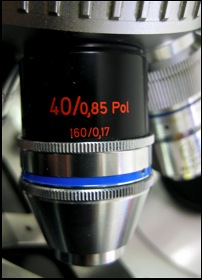Polarizing Microscopes
When purchasing a compound light microscope for a starch lab, I recommend a microscope designed for polarization rather than a biological microscope that is retrofitted with polarizing lenses. There are several reasons for this recommendation, all of which lead to the bottom line: you can see and study archaeological starches at higher resolution with a polarizing scope. Better clarity will result in both an improved likelihood of identification as well as higher quality images for publications.
Polarizing or pol microscopes are better for starch work than biological compound light microscopes for one main reason: they are built to optimize the control of polarized light. Regular microscope lenses are fitted with little metal collars that allow them to be seated properly inside the instrument. These collars cause strain in the glass, and this strain can produce optical aberrations that will interfere with your view of important characteristics of starch residues, especially birefringence. If you have ever studied potato starch using a biological compound microscope, you have seen the effects of this strain as a slight birefringence of the grains, even when the polarizer is not in use. In pol scopes, the collar has a little gasket inside it that prevents strain. These strain-free lenses allow you to control the polarization to an exceptionally high degree so that an extinction cross will be visible even in starches that are only two or three microns in maximum length. Additionally, pol scopes can be equipped with a 63x dry objective lens that will give you greater resolution in your photographs than a 40x lens on a biological scope will.
Polarizing microscopes are usually marketed as petrographic or materials instruments, and they tend to have circular stages that are used in these fields. You can ask your dealer to replace this circular stage with an X/Y stage that will allow you to scan slides with ease. Pol scopes also tend to be more expensive than biological scopes. The good news, however, is that there are some great dealers out there who have refurbished older scopes that work as well as new pol scopes, and are better for starch research than new biological scopes are. Vermont Optechs is one good resource.
When buying a pol microscope, most of your choices will be your personal preferences. There are a few critical features, however, that you will want to include.
- A trinocular head so that you can attach a camera and take pictures
- An X/Y stage for scanning instead of a circular stage
- A 15 or 20x objective lens for scanning
- A high power objective lens for close observations and for taking pictures


